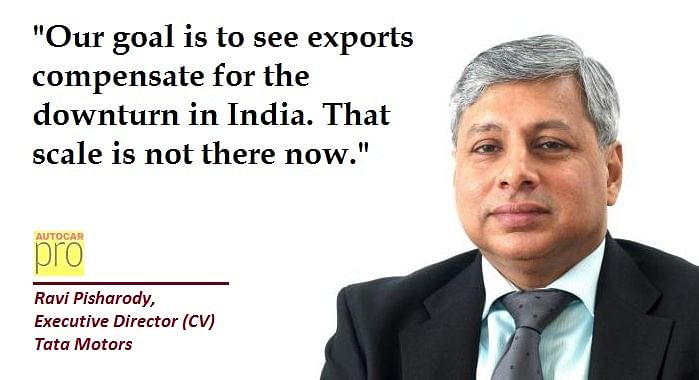Tata Motors pushes CV exports to ease domestic headwinds
Tata Motors' commercial vehicle division is targeting exports of 100,000 units by 2018 to offset domestic business cyclicality. We reveal the gameplan.
Tata Motors, India’s largest commercial vehicle manufacturer, is pursuing an aggressive export strategy to cushion itself from the cyclical nature of the domestic CV market. This involves both introducing new products and also expanding its footprint in key geographies.
Tata shipped 53,704 (+16.34%) CVs in 2015-16 and is gunning for more this fiscal. The Prima and Ultra range are key products in its exports drive and have been developed with modern design and aggregates with global markets in mind.
In an exclusive interview with Autocar Professional, Ravi Pisharody, executive director, commercial vehicles, Tata Motors, said: “Exports is an area on which we are focussing a lot and the goal is to see it at a level where the downturn in India is compensated by that. But today that scale does not exist and we are putting a lot of energy.”
At present, the key export markets are Africa, Middle East and Asia, which are experiencing troubled times due to local and global factors and pose a challenge for Tata Motors’ export strategy over the short term.
Taking a step forward, the company has also entered key East Asian markets such as Thailand, Indonesia, the Philippines, Malaysia and Vietnam. Barring Thailand, all the other markets are new and it is working to establish the brand, distribution and network before setting its eyes on scale, notwithstanding competition from local players.
Pisharody believes the export challenges are temporary and feels that volumes of nearly 100,000 units will make the company comfortable enough to offset the domestic business cyclicality. He is confident of reaching this critical volume in the next 2-3 years.
A threat to its export ambitions is the Thailand market, where it has been present for a number of years but has not made big gains. It now plans to expand beyond the Xenon pick-up and will soon launch the Prima, Super Ace and Ultra range of products as fully built vehicles. If volumes rise, it could go in for local assembly there.
For Tata Motors, its biggest export markets remain Bangladesh, Sri Lanka and Nepal. South Africa is another large market where it sells its full range of vehicles.
In the domestic market, the company has introduced a new brand called Signa to upgrade its mass market M&HCV range. Having launched the 49T in June, it will launch the 40T trailer in August and by September the entire portfolio (except the Prima) will be replaced by the Signa range.
Thinking big for small CVs
After nearly two years of a slump, the small commercial vehicle (SCV) segment is now seeing a sales recovery and, with a good monsoon this year, is poised to drive new gains. To protect its market share against an aggressive Mahindra & Mahindra, Tata Motors is in the process of launching two new products including a refreshed Xenon pick-up. Its Ace Mega has already gained traction and sales have been brisk.

Acknowledging the competition, Pisharody said, “Our competitors are extremely active and aggressive. That is not going to change because India is the only market where people really set their eyes and this is the only market good for the next five years. There is a lot of competition but our aim is to gain 3-5 percent market share in every category this year.”
Betting on tech
Commenting on the relevance of autonomous CVs in India, Pisharody said, “I don’t feel that will happen in the next five years. Before that, the Indian CV market will embrace other technologies such as sophisticated telematics, preventive diagnostic, electronic speed braking, Automated Manual Transmission, Automated Transmission and alternate fuels like hybrid and electric.”
The company is set to begin export of an automatic transmission-equipped Xenon pick-up and is considering rolling out the AMT-fitted Ultra range in the domestic market.
Tata Motors is also actively working on full- electric buses. In March this year, it bagged a contract to supply 25 Starbus Diesel Series Hybrid Electric buses to the Mumbai Metropolitan Region Development Authority. This is the single largest business awarded for hybrid EV tech in India. Despite the EV business path being unclear in terms of commercial viability, funding and infrastructure, Tata is going ahead with plans to put more such vehicles on India roads.
You may like: FY2016-17 opens to slowing India auto exports
RELATED ARTICLES
Bajaj Auto launches new Chetak 3503 at Rs 110,000
The Chetak 3503, with a claimed range of 155km, 63kph top speed and a slower charging time than its 35 Series siblings, ...
Hyundai walks the eco talk with biogas plant, material recovery plant in Gurugram
Operational since October 2022, the facility targets sustainable waste management in Gurugram by undertaking scientific ...
Rajiv Bajaj reappointed MD and CEO of Bajaj Auto for five-year term
Bajaj Auto’s Board of Directors has approved the re-appointment of Rajiv Bajaj as the company’s MD and CEO for another f...






 22 Aug 2016
22 Aug 2016
 7810 Views
7810 Views





 Autocar Professional Bureau
Autocar Professional Bureau




